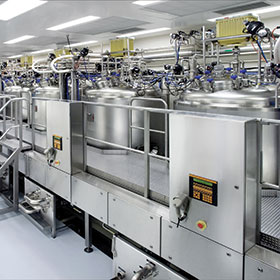

As drug production increasingly moves to emerging markets such as India, some US drug manufacturers are focusing more on the development of high value individual medicines. This shift is changing the structure of production plants, equipping them to run smaller batches. As a result, plants now have flexible manufacturing lines, which require tighter process control to avoid costly material and product losses.
Increasing importance of level measurement
With flexible manufacturing lines, small volumes of valuable materials and product are being moved frequently. To prevent transport and production vessels from being overfilled or emptying, highly accurate level measurement technology, such as optoelectronic sensors, are becoming increasingly important.
An optoelectronic sensor consists of an infrared LED and a light receiver. The light from the LED is directed at a prism that forms the tip of the sensor. So long as the tip is not immersed in liquid, the light is reflected within the prism to the receiver. As soon as a liquid surrounds the tip, the light beam is interrupted and no longer reaches the receiver, or does so only weakly. The receiver reacts by triggering the switching operation.
Optimal volume utilisation with optoelectronic technology
The important advantage of the optoelectronic method is that it operates independently of the density, viscosity, pressure, temperature, conductivity and dielectric constant of the liquid. Magnetic fields and vibrations also have no effect on it. Furthermore, optoelectronic technology can provide high accuracy up to 0,5 mm, whereas instruments using vibrating forks only achieve an accuracy of 2 to 3 mm. The use of optoelectronic measurement also enables optimal volume utilisation, even as the diameter of the vessel reduces.
Autoclavable optoelectronic level design prevents contamination risk
Many of the vessels used in pharmaceutical processes are mobile. As a rule, they are sterilised in an autoclave where germs and bacteria are killed under saturated steam at a temperature up to 135°C and at a pressure of 3 bar. If built-in electronic measuring instruments can withstand this process for approximately 20 minutes, they do not need to be dismounted beforehand. If this is the case, the vessel can remain closed after sterilisation, which prevents the risk of contamination that is possible when measurement instruments must be refitted.
Autoclavable optoelectronic level technology is available to prevent contamination risk. All the components of these instruments, including the printed circuit boards and solder points of the electronics, are designed to withstand the saturated steam sterilisation process.
Besides specially designed optoelectronic level instruments, there are alternative autoclavable methods for level measurement. The most common include: an optical onsite display through a sight glass; or a quantitative measurement, which is taken during the filling process. However, both present the risk of under or overfilling. For example, media can flow in from the lines between the manual shutting off and the actual stopping of the filling process, creating an opportunity for error. A level switch can be added to provide additional safety and accuracy because its sensor triggers the filling process to start or stop at the correct time, but there is an extra cost involved.
Advanced optoelectronic sensor designs for compact spaces
Small batch manufacturing processes are also driving pharmaceutical production facilities to pursue a small-scale approach, which includes measurement components. Instrumentation companies are following suit with optoelectronic level designs that offer minimum clearance, the glass tip of the sensor to the opposite surface is calculated to be 10 mm. With the help of a fitting, some optoelectronic switches can also be installed into narrow pipelines to protect against dry-running.
With a range of performance, optoelectronic level technology is keeping pace with the efficiency and flexibility required in pharmaceutical production. New advancements provide accurate, repeatable measurements as well as various installation options to help plants standardise on instrumentation, driving further operational and cost efficiencies.
| Tel: | +27 11 621 0000 |
| Email: | [email protected] |
| www: | www.wika.co.za |
| Articles: | More information and articles about WIKA Instruments |

© Technews Publishing (Pty) Ltd | All Rights Reserved